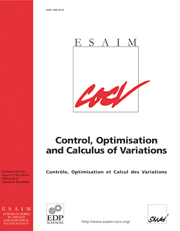Crossref Citations
This article has been cited by the following publications. This list is generated based on data provided by
Crossref.
Mielke, A.
Peletier, M. A.
and
Renger, D. R. M.
2014.
On the Relation between Gradient Flows and the Large-Deviation Principle, with Applications to Markov Chains and Diffusion.
Potential Analysis,
Vol. 41,
Issue. 4,
p.
1293.
VAN MEURS, P.
MUNTEAN, A.
and
PELETIER, M. A.
2014.
Upscaling of dislocation walls in finite domains.
European Journal of Applied Mathematics,
Vol. 25,
Issue. 6,
p.
749.
Peletier, Mark A.
Redig, Frank
and
Vafayi, Kiamars
2014.
Large deviations in stochastic heat-conduction processes provide a gradient-flow structure for heat conduction.
Journal of Mathematical Physics,
Vol. 55,
Issue. 9,
Duong, Manh Hong
Peletier, Mark A.
and
Zimmer, Johannes
2014.
Conservative‐dissipative approximation schemes for a generalized Kramers equation.
Mathematical Methods in the Applied Sciences,
Vol. 37,
Issue. 16,
p.
2517.
Erbar, Matthias
Maas, Jan
and
Renger, Michiel
2015.
From large deviations to Wasserstein gradient flows in multiple
dimensions.
Electronic Communications in Probability,
Vol. 20,
Issue. none,
Fathi, Max
2016.
A gradient flow approach to large deviations for diffusion processes.
Journal de Mathématiques Pures et Appliquées,
Vol. 106,
Issue. 5,
p.
957.
Bonaschi, Giovanni A.
and
Peletier, Mark A.
2016.
Quadratic and rate-independent limits for a large-deviations functional.
Continuum Mechanics and Thermodynamics,
Vol. 28,
Issue. 4,
p.
1191.
Schlichting, André
Laschos, Vaios
Fathi, Max
and
Erbar, Matthias
2016.
Gradient flow structure for McKean-Vlasov equations on discrete spaces.
Discrete and Continuous Dynamical Systems,
Vol. 36,
Issue. 12,
p.
6799.
Dirr, Nicolas
Stamatakis, Marios
and
Zimmer, Johannes
2016.
Entropic and gradient flow formulations for nonlinear diffusion.
Journal of Mathematical Physics,
Vol. 57,
Issue. 8,
Mielke, Alexander
Renger, D. R. Michiel
and
Peletier, Mark A.
2016.
A Generalization of Onsager’s Reciprocity Relations to Gradient Flows with Nonlinear Mobility.
Journal of Non-Equilibrium Thermodynamics,
Vol. 41,
Issue. 2,
p.
141.
Duong, M H
Lamacz, A
Peletier, M A
Schlichting, A
and
Sharma, U
2018.
Quantification of coarse-graining error in Langevin and overdamped Langevin dynamics.
Nonlinearity,
Vol. 31,
Issue. 10,
p.
4517.
Renger, D. R. Michiel
2018.
Gradient and GENERIC Systems in the Space of Fluxes, Applied to Reacting Particle Systems.
Entropy,
Vol. 20,
Issue. 8,
p.
596.
Pal, Soumik
and
Wong, Ting-Kam Leonard
2020.
Multiplicative Schrödinger problem and the Dirichlet transport.
Probability Theory and Related Fields,
Vol. 178,
Issue. 1-2,
p.
613.
Mikami, Toshio
2021.
Stochastic Optimal Transportation.
p.
21.
MIKAMI, Toshio
2021.
Regularity of Schrödinger's functional equation in the weak topology and moment measures.
Journal of the Mathematical Society of Japan,
Vol. 73,
Issue. 1,
Mikami, Toshio
2021.
Stochastic Optimal Transportation.
p.
1.
Conforti, Giovanni
and
Tamanini, Luca
2021.
A formula for the time derivative of the entropic cost and applications.
Journal of Functional Analysis,
Vol. 280,
Issue. 11,
p.
108964.
Bernton, Espen
Ghosal, Promit
and
Nutz, Marcel
2022.
Entropic optimal transport: Geometry and large deviations.
Duke Mathematical Journal,
Vol. 171,
Issue. 16,
Heida, Martin
2022.
Stochastic homogenization on perforated domains II – Application to nonlinear elasticity models.
ZAMM - Journal of Applied Mathematics and Mechanics / Zeitschrift für Angewandte Mathematik und Mechanik,
Vol. 102,
Issue. 12,
Renger, D R Michiel
2022.
Anisothermal chemical reactions: Onsager–Machlup and macroscopic fluctuation theory.
Journal of Physics A: Mathematical and Theoretical,
Vol. 55,
Issue. 31,
p.
315001.


